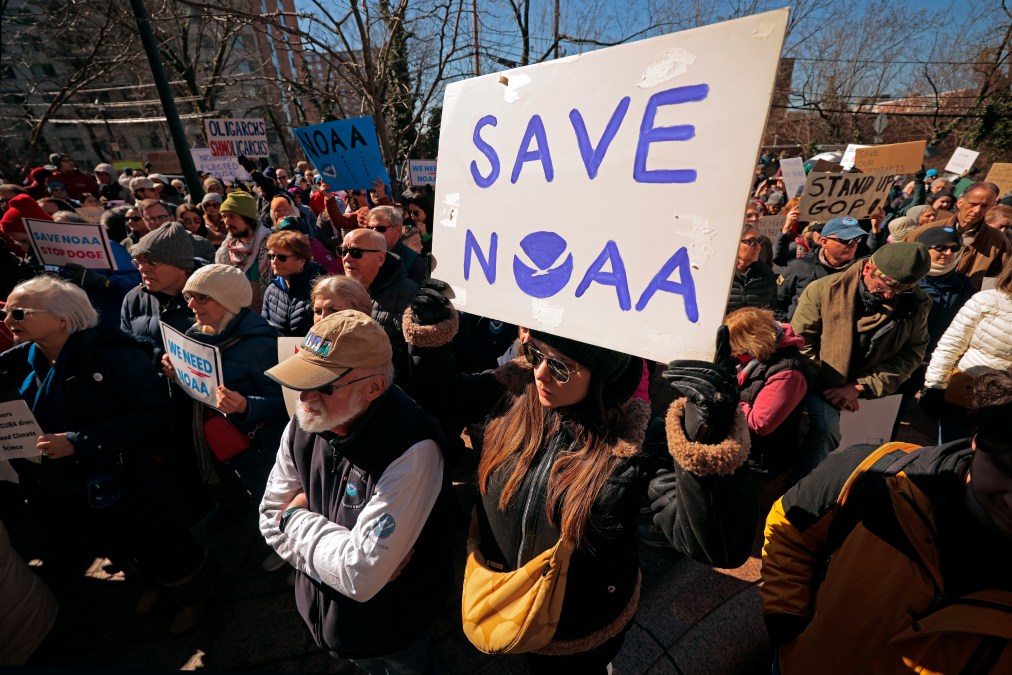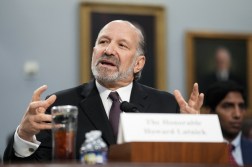NOAA firings spark concerns for agency’s data-centric mission

Firings at the National Oceanic and Atmospheric Administration have former workers, lawmakers, and advocates concerned about impact on the agency’s efforts to produce climate and weather information critical to public safety.
NOAA is one of many federal agencies in the U.S. that has cut probationary workers in recent weeks as part of President Donald Trump’s plan to reduce the size of the federal government. While critics of the Trump administration have argued the rapid and widespread staffing reductions could have adverse consequences across the government, the picture they paint with respect to NOAA’s terminations is particularly grim.
That’s because the agency’s mission impacts every American, former NOAA workers told FedScoop. The recent cuts to staff put that work at risk, particularly for areas at the agency where staffing levels were already an issue, they said. What’s more, there are areas outside of staffing cuts where efficiencies could have been achieved through consolidating work and technology advancements.
“What we do is for everybody,” Andy Hazelton, a former physical scientist for the National Weather Service who was among the probationary workers who lost their jobs, said of NOAA’s mission. There are changes expected with new presidential administrations, Hazelton told FedScoop, but the “unprecedented level of just systematic dismantling, I think, has got people rightfully up in arms.”
The weather and climate agency’s responsibilities range from weather forecasting and climate monitoring to tracking and studying severe weather and stewarding the nation’s fisheries. Specifically, that translates into activities such as providing the data for local forecasts, flying planes through hurricanes to collect more precise information about the storm’s potential impact, and conducting underwater surveys of fish populations to inform industry and prevent overfishing.
Timothy Gallaudet, who served as assistant secretary of commerce for oceans and atmosphere and acting NOAA administrator during the first Trump administration, criticized the firings in an interview with FedScoop as an ineffective way to improve government.
Instead, Gallaudet suggested focusing on eliminating redundancies within the government to improve efficiency. For example, he said multiple agencies conduct climate modeling, which would be better centralized at NOAA.
“Those redundancies are replete across the government, and that’s just the better way. They didn’t really put any thought, in my opinion, to these firings,” Gallaudet said.
Probationary firings, more possible
NOAA terminated roughly 650 probationary workers last month, according to a spokesman for Sen. Chris Van Hollen. The Maryland Democrat, who has been vocal about the terminations, is the ranking member of a Senate appropriations subcommittee with oversight of NOAA. The chair of that subcommittee, Sen. Jerry Moran, R-Kan., didn’t respond to requests for comment.
On Wednesday, the Associated Press and USA Today reported that the agency told people internally it was laying off an additional 1,000 workers.
NOAA declined to confirm the number of probationary workers who were fired, citing a longstanding practice of “not discussing internal personnel and management matters,” and referred FedScoop’s inquiry about the 1,000 workers figure to the Department of Commerce. Commerce has not responded to multiple emailed requests for comment.
In response to an inquiry about concerns that NOAA could struggle following cuts to staff, however, a NOAA spokeswoman provided a statement that the agency is continuing its work.
“NOAA remains committed to its mission, providing timely information, research and resources that serve the American public and ensure our nation’s environmental and economic resilience,” the spokeswoman said. “We continue to provide weather information, forecasts and warnings pursuant to our public [safety] mission.”
Since the second Trump administration began, advocates have expressed concern about NOAA’s future, given a recommendation in the Heritage Foundation’s Project 2025 that the agency should be dismantled. Although Project 2025 is not directly affiliated with the Trump administration, some policies are aligned with the administration’s actions and Office of Management and Budget Director Russell Vought was one of its authors.
Commerce Secretary Howard Lutnick, however, said he had no interest in separating the agency and it wasn’t part of his agenda during his confirmation hearing.
Leading up to the firings, Congressional Democrats urged Lutnick to protect NOAA employees and other Commerce employees from the mass firings. Democrats on the House Committee on Science, Space and Technology said those firings would risk Americans being “unprepared for the next extreme weather event, and lives may be lost that could have been saved.”
During a recent call with press, Van Hollen similarly said the terminations could result in harm to people. “NOAA, of course, is our first line of defense against extreme weather events. They’re our eyes and ears,” Van Hollen said, adding that “when you close your eyes and you plug your ears, people will get hurt.”
Backfilling positions
Former officials told FedScoop that the probationary firings will primarily deprive NOAA offices of staff they already needed following departures.
“This will just exacerbate a problem of not having enough people to do what they need to do — and do it well, and accurately, and reliably,” Gallaudet said of the terminations. He added: “That pretty much involves every NOAA mission.”
Nicole Rice, a former communications specialist at NOAA’s Great Lakes Environmental Research Laboratory who was among those fired, told FedScoop many probationary status workers are backfilling positions for continuity of operations.
“We had a ton of retirees over the last few years, so these were positions that were being back filled. These are not new positions,” Rice said. “We were not creating additional positions.”
Hazelton, who worked on hurricane modeling, similarly said the Environmental Modeling Center where he worked had a lot of probationary people following retirements. The component was “just starting to get back to where you want to be staffing wise,” he said. “And then this happened, and now it’s just back to a rough situation.”
Probationary status, which lasts roughly one to two years in the federal government, occurs after an employee is hired or after they’re promoted. In some cases, employees on probationary status were working for the agency for years on a contract or other means and were then directly hired.
In Rice’s case, she had worked for NOAA for 10 years but was only on probationary status because she had been promoted.
Hazelton, meanwhile, had worked at NOAA for over eight years in various capacities, including as a postdoctoral researcher after he received his PhD in meteorology from Florida State University and as a scientist at the University of Miami working with NOAA’s Hurricane Research Division. In October, he was officially hired by NWS.
Hazelton said he was probationary in the sense that he was a new federal employee, “but I was definitely not a new NOAA employee.”
Impact of cuts
Storm warnings and hurricane research and monitoring are among the most immediate impacts that former workers cited.
Hazelton said terminations hit a variety of roles, including jobs involving data collection, modeling, quality control, and computer expertise. Not having those workers could result in fewer people available to issue warnings and develop and test models, as well as a lack of certain types of data and a potential slowing or reversal of “some of the forecast improvements that we come to rely on,” Hazelton said.
The firings also impacted the Hurricane Hunters, he said, which is the team responsible for flying two Lockheed WP-3D Orion planes into hurricanes to better understand the storm.
In a government watchdog report released Friday, staff shortages and maintenance issues were specifically cited as hurdles officials said prevented the Hurricane Hunters from meeting the rising demand for their work amid increased tropical cyclone activity.
Gallaudet similarly pointed to severe weather warnings, noting that those warnings go to every county in the country to alert people to severe events like hurricanes, blizzards, high winds, and thunderstorms. “That’s what affects most people in the country,” he said.
When asked how firings at NOAA might impact the economy, Gallaudet highlighted the agency’s work managing fisheries, stewarding marine sanctuaries, and supporting sea ports. Issues with NOAA’s work observing and monitoring current water levels and surveying sea ports, for example, could disrupt the operation of those facilities, which contribute roughly $2.9 trillion to the U.S. economy, he said.
The way the agency interacts with the public and produces research will also likely be impacted.
Rice said the entire communications team was fired at her office, so there isn’t any messaging coming out of the laboratory. That lab studies the stressors on the Great Lakes, such as harmful algal blooms, invasive species, extreme weather impact, and ice cover, she said. “There is no one left to discuss science with the community,” Rice said.
Her absence alone might interfere with a statutory requirement. Rice was the program manager for publishing the lab’s results consistent with the Public Access to Research Results Act, which requires scientific entities in the government to produce their research in a timely manner.
“There is no one who has access to that system or the ability to do that, so we will not be able to complete that mission,” she said.
Areas for efficiency
During Trump’s first term, Gallaudet said NOAA was able to do good work and was, for the most part, “left alone” by the administration. “The White House liked a lot of what we were doing, so we advanced some initiatives,” he said.
But Gallaudet — who described himself as a conservative who agrees with some of the current administration’s policies — said he didn’t want to work for Trump again, criticizing his leadership and his divisiveness. He’s set to publish a book on his experience at NOAA during the first administration in August.
In addition to getting rid of repeated work, Gallaudet said another area NOAA could focus on to gain efficiency instead of staffing cuts is its advances in artificial intelligence and autonomous technologies.
Drones are being used to map the sea floor, measure wind speed in hurricanes, and observe weather and currents. AI, meanwhile, is being used by the agency to automate tasks, improve modeling and forecasts, and support decision making, he said.
“We put in some really smart things to make NOAA more efficient,” Gallaudet said, adding that this administration could follow that playbook and build on it.
Hazelton was directly working on some of those AI efforts.
At the Environmental Modeling Center, he helped write the component’s plan for how it planned to use AI over the next five to 10 years to improve forecasting. He said he could see AI as the way forward for a lot of things, and being a part of that work was one of his professional development goals for this year. That is, before he was fired.
“The thing is, getting rid of younger … talented people is not the way to move an organization into the future,” Hazelton said.






